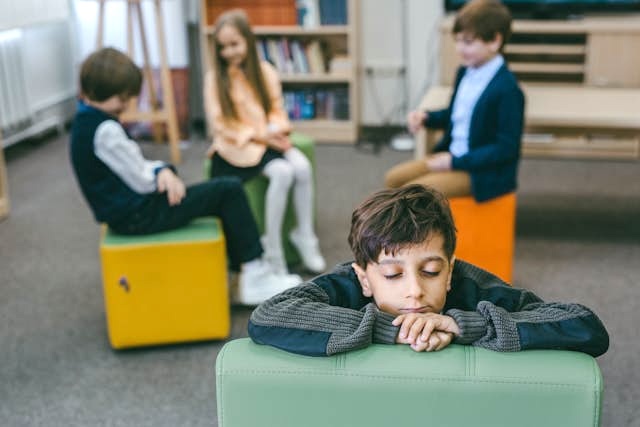
Autistic kids spend a lot of time in school learning how to cope with an environment that is often out of sync with their abilities and challenges.
Sensory Sensitivity
Autistic kids have sensory differences in any environment, but these challenges can be even more pronounced at school. Everyday school life includes hall bells and buzzers, fluorescent lights, loud voices, food smells from the cafeteria, and echoes in the gym or auditorium.
The sensory stimuli can be overwhelming for autistic kids and trigger extreme anxiety, increased self-stimulatory behaviors (stimming), and internalized physical symptoms like headaches.
As students go back to school each fall, they find that some aspects of their day are the same as they were last year, while other things have changed. Change can be hard for any student to adjust to, but autistic kids can find it even more difficult to adapt.
Reading and Verbal Comprehension
Standardized testing in schools requires children to comprehend and respond to spoken and written language at a speed and level that’s expected for their age. The testing starts when they’re very young, and a child’s verbal acuity and comprehension are expected to increase as they get older.
Autistic kids can be at a disadvantage when they have to do standardized testing because verbal expression and comprehension are major challenges for them—particularly using and understanding figurative or expressive language.
Executive Functioning
Executive functioning is the ability to plan and carry out multi-step projects while taking project parameters, timelines, and other factors into account at the same time.
Autistic people are typically less comfortable switching between activities, tasks, and topics. Executive function can be a major challenge for autistic kids in all areas of life, including at school.

Social Communication
In school, social interactions are everywhere and constantly changing. What’s appropriate in the classroom could be inappropriate in the halls, gym, or playground. An autistic child may not pick up on social cues that tell them to change their behavior to fit a situation.
Since they also have different communication skills, it can be difficult for autistic children to tell playful teasing from bullying or understand the difference between sarcasm and fact.

Check out our podcast to gain a deeper understanding of the unique challenges a child with autism encounters at school and learn how to leverage their strengths to support their learning journey.
Changing Rules and Expectations
As students go back to school each fall, they find that some aspects of their day are the same as they were last year, while other things have changed. Change can be hard for any student to adjust to, but autistic kids can find it even more difficult to adapt.
Changes also happen with peers—what was “cool” last year is decidedly “uncool” the next. Autistic kids can be ridiculed, bullied, or ignored by others who don’t understand their needs and differences.

Fine and Gross Motor Skills
Fine motor skills are necessary for writing, drawing, cutting, pasting, and manipulating small objects such as microscope slides and tweezers. Gross motor skills are used for bigger movements, like jumping, kicking, throwing, running, and skipping.
Autistic children commonly have mild to moderate difficulty with these skills. This includes motor planning in which a child anticipates doing an action (such as kicking a ball) and positions the body to do that movement.
Changes in Routines
Autistic people typically thrive when they have routine and structure. While school life is based on specific routines and goals, there are times when things will be different.
Therapy sessions and social skills groups are meant to help children learn how to cope. However, these interventions can also be disruptive when they take kids out of class—often in the middle of a lesson.
Acceptance of Autistic Behaviors
Some teachers are frustrated when an autistic child talks too much about a special interest, has trouble collaborating with their peers, or starts stimming in class.
Even if a teacher does want to help, an autistic student can still get left behind. An educator won’t always have the resources and support they need to connect an autistic child with tutors and programs that could address their needs and help them be part of the classroom.
Excerpted from “Why Is School So Challenging for Autistic Children?” in Verywell Health. Read the full article online.
Source: Verywell Health | Why Is School So Challenging for Autistic Children?, https://www.verywellhealth.com/why-school-is-so-challenging-4000048 | Ⓒ 2024 Dotdash Media, Inc.
This resource is filed under:





